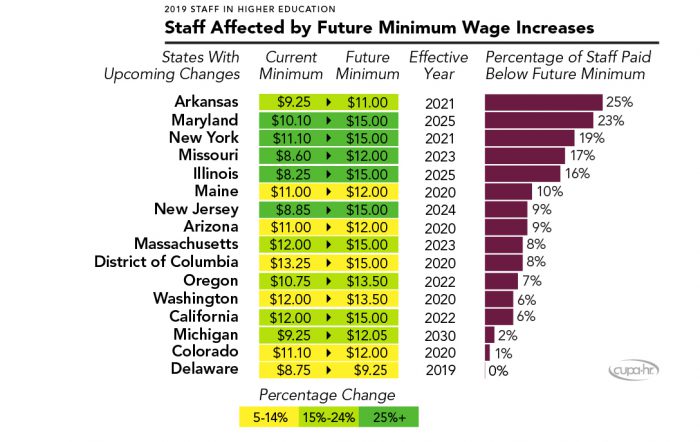Many Higher Ed Staff Will See Larger Paychecks in Coming Years as State-Level Minimum Wage Increases Take Effect
Fifteen states and the District of Columbia have passed legislation raising the minimum wage to a specific amount over the next several years, and many workers at the staff level in higher education institutions in those states will be impacted.
According to just-released findings from CUPA-HR’s Staff in Higher Education Survey, around one in four higher ed staff employees currently earn less than $15 per hour — a key threshold since at least six states and D.C. have targeted a $15 minimum wage.
Across all the 15 states and D.C. that have legislated future increases, a combined 11 percent of staff are paid less than the new minimum wage passed in their state. This means that hourly rates for these individuals would need to be at or above the new minimum wage when those laws go into effect.

However, the survey found that institutions are impacted differently by these impending increases depending on their affiliation, with private institutions paying a much higher percentage of their staff (17 percent at private religious institutions and 14 percent at private independent institutions) less than the future minimum in their state, compared to only 8 percent at public institutions.
Likewise, institutions classified as master’s and baccalaureate pay a much higher percentage of their staff (17 percent and 16 percent, respectively) less than their state’s future minimum wage than do doctoral (9 percent) or associate’s (5 percent) institutions.
“It’s important to note that the new minimum wage doesn’t just impact the lowest-paid employees,” says Andy Brantley, president and CEO of CUPA-HR. “Colleges and universities will need to review their pay structures to determine how the hourly rates of multiple levels of positions will need to be adjusted to avoid wage compression.”
Other findings from the 2019 CUPA-HR Staff in Higher Education Annual Report include:
- Salary increases. The median salary increase for higher ed staff over the past year was 1.88 percent. The median salary increase was highest at baccalaureate institutions (1.99 percent) and lowest at associate’s institutions (1.52 percent).
- Most common staff positions. Most higher ed staff work in either office/clerical positions (41 percent) or service/maintenance positions (34 percent). The two most common positions are custodian/housekeeper and administrative assistant, each making up around 14 percent of the staff workforce.
- Job growth. The position of graphic design paraprofessional experienced the most job growth this year (26 percent increase), whereas building control systems technician saw the largest decline (24 percent decrease).
- Demographics. Women make up 61 percent of higher ed staff overall, and minorities make up 31 percent of staff.
- Pay equity. Women are paid less than equitably compared to men in all staff areas except for office/clerical positions. Minorities (except Asians) are paid less in the same position than are White staff across all areas.
A total of 857 higher education institutions provided incumbent-level data for 205,949 staff in 153 positions for this year’s survey. The survey collects data on salaries and demographics for each individual incumbent, allowing for more in-depth analysis and comprehensive benchmarking. Data collected include salary, sex, race/ethnicity, age and years in position.
For a list of participating institutions, an overview of the results, information on data collected and options for purchasing the survey report and DataOnDemand, visit the Staff in Higher Education web page.


